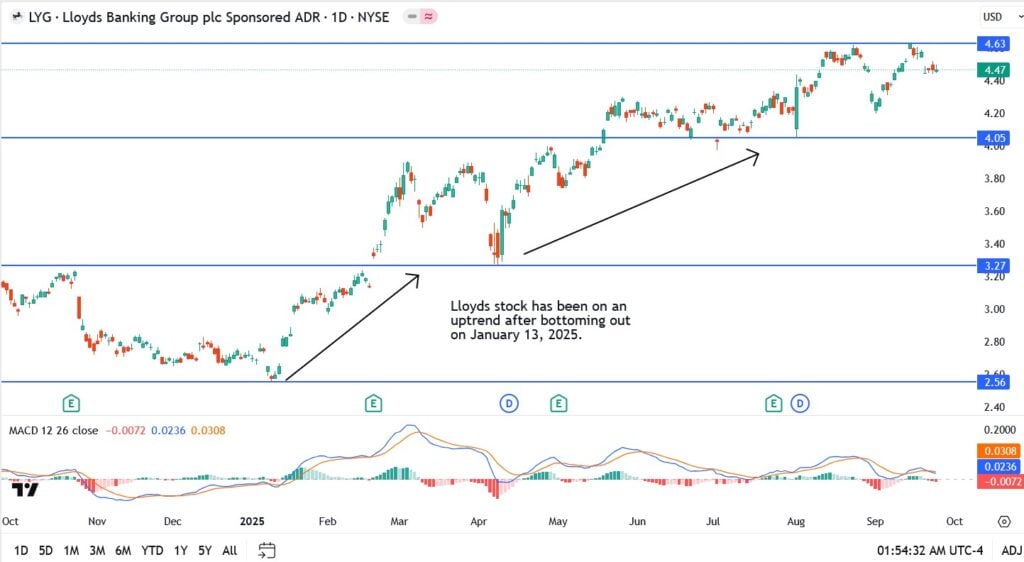- Lloyds Bank to close 49 branches in 2026, including Halifax and Bank of Scotland sites. What this means for customers and investors.
Lloyds Banking Group has confirmed it will shut 49 more branches across the UK in 2026, marking another step in its gradual retreat from the high street. The closures, which will affect sites under the Lloyds Bank, Halifax, and Bank of Scotland brands, are scheduled to roll out between January and October next year as the lender accelerates its shift toward digital banking.
For customers, the decision means fewer local branches, though Lloyds insists that alternatives remain available through Post Offices, PayPoint outlets, and newly recommended banking hubs. For investors, the closures underline the group’s strategy to cut costs while leaning more heavily into digital growth.
Lloyds Bank Branch Closures 2026: Full List and Investor Impact
Of the 49 sites affected, 26 are Lloyds branches, 10 are Halifax locations, and 13 are Bank of Scotland branches. In Wales, closures will include Ammanford in Carmarthenshire, Gorseinon in Swansea, and Chepstow in Monmouthshire.
Once the closures are complete, Lloyds will still operate 705 branches nationwide, made up of 359 Lloyds, 269 Halifax, and 77 Bank of Scotland sites. The bank has said that all staff impacted will be offered roles elsewhere in the business, limiting the risk of direct job losses.
Why Lloyds Is Cutting Back on Branches
The bank has been clear about the reason: customer behavior is changing. More than 21 million people now use Lloyds’ mobile apps to manage their accounts, apply for loans, or make payments. That figure has grown rapidly over the past five years and has sharply reduced demand for in-person banking services.
A Lloyds spokesperson said the group is “providing more choice than ever before, bringing together the best in digital convenience with our people.” Meanwhile, cash access provider Link has recommended 11 new shared banking hubs to help communities affected by branch closures.
Lloyds Banking Group Chart Analysis Today
- Current price: $4.47
- Support: $4.40 and $4.05
- Resistance: $4.63 and $4.75-$5.00

Trade Setup: Lloyds is pausing just under resistance. Holding above $4.40 keeps buyers in charge, while a close through $4.63 would likely open the path toward $4.75 and $5.00. If $4.05 gives way, momentum could shift back to the downside.
Lloyds Bank Branch Closures: Impact on Customers and Communities
While the digital shift is undeniable, the latest wave of branch closures has raised concerns in smaller towns and rural areas where cash access remains important. Customers in Wales, for example, will face longer travel times once their local branches shut.
This is not unique to Lloyds. Other banks, including NatWest, have also announced branch and mobile unit closures in recent weeks. It’s a broader industry trend that’s redefining how people interact with banks in the UK.
Lloyds Share Price Outlook: What Branch Closures Mean for Investors
Despite the headline closures, Lloyds stock remains resilient. As of today, shares trade at around $4.47, just shy of their recent highs. Chart analysis shows key support levels near $4.05 and resistance closer to $4.63.
For investors, the closures can be seen as part of a cost-discipline strategy. By cutting expenses tied to physical branches, Lloyds is doubling down on digital banking, a space where margins are higher and growth potential is clearer.
Personally, I see this less as a retreat and more as a reset. Lloyds is trimming costs on the high street while building scale in digital services, a shift that could support both profitability and competitiveness in the years ahead.
Lloyds Banking Group FAQs
Lloyds says customer habits have changed, with over 21 million people now managing their money through its mobile apps. Fewer people are visiting branches, so the group is reducing its physical network while investing more in digital banking.
Lloyds has said the staff working in the affected branches will be offered roles elsewhere in the group. That means people won’t be left without a job, though some may need to move to a different branch or team.
For investors, the closures are really about cutting costs and pushing harder into digital banking. In the short term, the share price still reacts to wider market news, but over time these changes could make Lloyds a leaner and more profitable business.


